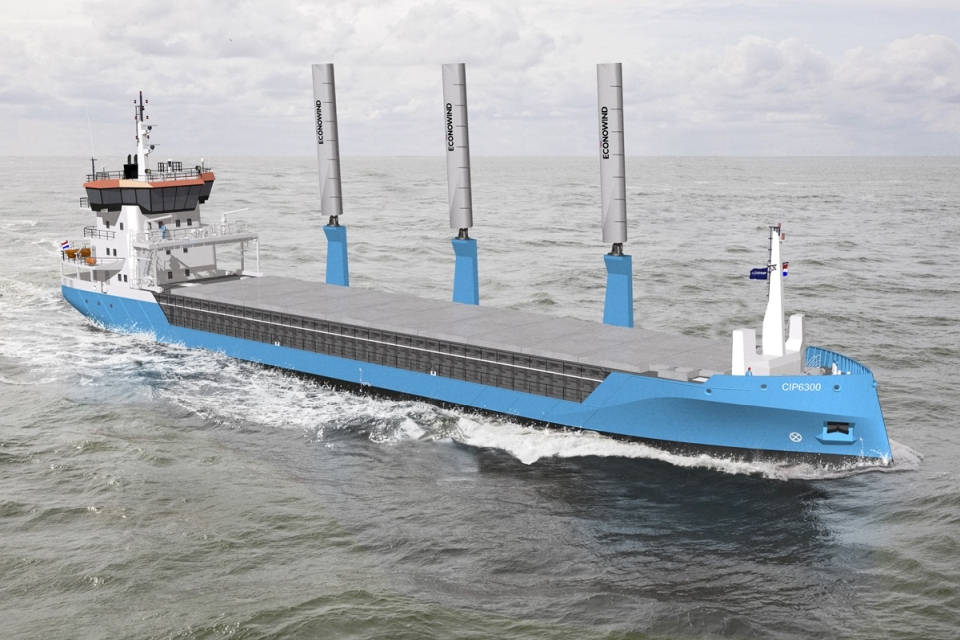Conoship International has revealed the CIP6300, a future-ready cargo vessel design. Equipped with a diesel-electric propulsion system, the CIP6300 boasts optimised hull lines and a large propeller diameter and is ready for wind-assisted propulsion.
One notable feature that sets this vessel apart is its compatibility with wind-assisted ship propulsion (WASP). Embracing wind-assisted propulsion underscores the commitment to reducing carbon emissions and minimising the vessel’s ecological footprint. Applying WASP would reduce fuel consumption and CO2 emissions by about ten per cent, depending on the sailing route.
A large propeller diameter is a key element in ensuring optimal propulsion efficiency. The CIP 6300 follows the CIP3600 and CIP3800.
Also read: Conoship to design autonomous zero-emission short sea vessel Zulu Mass
Versatility and adaptive fuel options
With a single, spacious cargo hold boasting high cubic capacity, the CIP6300 is well-equipped to handle a diverse range of cargo, whether heavy or light. With this flexibility, Conoship seeks to meet the evolving needs of the maritime industry.
Perhaps one of the most groundbreaking aspects of this vessel is its adaptability in fuel selection. The well-thought-out design allows for the possibility of changing the type of fuel in the future without the need for a radical and costly conversion. This feature is especially important as the industry transitions towards cleaner, alternative fuels.
‘For example, take off the generators and replace them with a methanol power generator set and then put in methanol tanks as well, or take them off completely and put on liquid hydrogen tanks and fuel cells,’ explains Jan Jaap Nieuwenhuis, managing director at Conoship. ‘All these redesign possibilities were taken into account from the beginning of the conceptual design process.’
Also read: Vega orders ten Conoship Eco coasters
Advantages of a standard vessel
The CIP series can be built at a shipyard of the client’s choice. By designing and building for a specific market and standardising certain ship types, product innovations can be introduced more easily and with less risk. So, investing in a standard design has financial benefits as the design package is more affordable.
Standardisation of the design also speeds up the delivery time, which is reduced for up to one year.
Also read: Wilson orders six Conoship designed short sea vessels
Propulsion and capacities
The vessel is powered by four gensets and two electric motors, ensuring smooth and efficient propulsion. A 350 bkW bow thruster enhances manoeuvrability.
The spacious cargo hold measures 66.66 metres in length, 13.15 metres in breadth, and 10.60 metres in height. With a tanktop load of 15 t/m², it can accommodate a remarkable 317,000 cubic feet of cargo.
Technical Specifications
The key technical specifications of the CIP6300 General Cargo Vessel are:
- Length overall: 99.99 metres
- Breadth molded: 15.85 metres
- Depth to main deck: 8.80 metres
- Deadweight: 6375 tonnes
- Gross tonnage: 4657
- Cargo hold capacity: 8978 m³ or 317,055 ft³
- Service speed: 10.00 knots
Fuel consumption:
- 8 kn ≈ 2.5 t/day
- 9 kn ≈ 3.2 t/day
- 9.5 kn ≈ 3.9 t/day
- 10 kn ≈ 4.4 t/day
- 10.5 kn ≈ 4.8 t/day
Also read: New Conoship-designed general cargo vessel is taking shape








